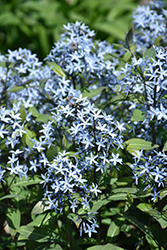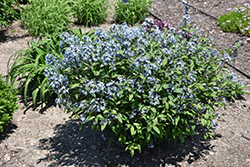Storm Cloud Bluestar
Amsonia tabernaemontana 'Storm Cloud'
Height: 30 inches
Spacing: 3 feet
Sunlight:
![]()
![]()
Hardiness Zone: 4
Other Names: Blue Star Flower
Brand: Proven Winners
Description:
Incredibly dark stems emerge from the ground in spring, producing olive green leaves with silver veins; beautiful periwinkle blue, star-shaped flowers in springtime, on a wide, mounding, shrubby habit; does best in moist, well-drained soil
Ornamental Features
Storm Cloud Bluestar's attractive narrow leaves are olive green in color with distinctive silver veins on a plant with a round habit of growth. As an added bonus, the foliage turns a gorgeous yellow in the fall. It features showy clusters of powder blue star-shaped flowers at the ends of the stems from late spring to early summer. The flowers are excellent for cutting. The black stems are very colorful and add to the overall interest of the plant.
Landscape Attributes
Storm Cloud Bluestar is an herbaceous perennial with a more or less rounded form. Its medium texture blends into the garden, but can always be balanced by a couple of finer or coarser plants for an effective composition.
This is a relatively low maintenance plant, and should be cut back in late fall in preparation for winter. Deer don't particularly care for this plant and will usually leave it alone in favor of tastier treats. It has no significant negative characteristics.
Storm Cloud Bluestar is recommended for the following landscape applications;
- General Garden Use
- Naturalizing And Woodland Gardens
Planting & Growing
Storm Cloud Bluestar will grow to be about 30 inches tall at maturity, with a spread of 4 feet. When grown in masses or used as a bedding plant, individual plants should be spaced approximately 3 feet apart. It grows at a slow rate, and under ideal conditions can be expected to live for approximately 20 years. As an herbaceous perennial, this plant will usually die back to the crown each winter, and will regrow from the base each spring. Be careful not to disturb the crown in late winter when it may not be readily seen!
This plant does best in full sun to partial shade. It prefers to grow in average to moist conditions, and shouldn't be allowed to dry out. It is not particular as to soil type or pH. It is somewhat tolerant of urban pollution. This is a selection of a native North American species. It can be propagated by cuttings; however, as a cultivated variety, be aware that it may be subject to certain restrictions or prohibitions on propagation.

